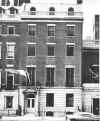|
notes
|
A
Brief History of the Institute
|

|
The
origins of the Istituto Italiano di Cultura of New York date
back to 1956 when an information agency on Italy and Italian
culture operated out of the Italian Consulate. In 1958, when the
Italian government acquired the building at 686 Park Avenue
(adjacent to the Italian Consulate building), the Agency moved
into the new prestigious office, and in 1961 Istituto Italiano
di Cultura was opened.
The Institute
is a stately building in the 1919 neo-Georgian / neo-Federal
style, the work of architects Delano & Aldrich. The
five-floor building with a terrace and an interior garden is
a New York city landmark along with the other stately
structures that face onto the same stretch of Park Avenue
between 68thand 69th Streets. Besides the Italian
Consulate at 690 Park Avenue (built in 1917 by
architects Walker & Gillette), the Spanish Institute
at no. 684 and the Americas Society at no. 680 make
up this group.
|
Originally, the Cultural Institute worked in close collaboration
with Casa Italiana of Columbia University, the oldest
institution representing Italian culture in New York, inheriting
also part of the Italian book and newspaper collection previously
housed in Casa Italiana's Charles Paternò Library. In fact
Giuseppe Prezzolini (professor of Italian at Columbia University
since 1923 and director, until 1933, of Casa Italiana) contributed
to the Istituto Italiano di Cultura's beginning until 1962 when he
left the United States.
For nearly 12 years,
from 1964 to 1976, the Institute was under the direction of Prof.
Giuseppe Cardillo. His activities consisted essentially of those
connected to the information agency: bibliographical information;
cataloguing of newspaper and magazine articles; strong connections
with the community of Italian origin in New York; the publication of
periodical news bulletins. A different approach was taken by
Prof. Marco Miele, director from 1976 to 1982, and subsequently
by Prof. Lia Beretta (1982-84), with a greater attention to
the organization of cultural and social events appealing to a wider
local audience. After a long period with the position unfilled, the
direction was assumed by Prof. Gianclaudio Macchiarella in
1988. He focused on the creation of cultural services in the areas
of the promotion of Italian language and culture and in establishing
steady relationships of collaboration with the city's major cultural
institutions.
After the
reformation of Cultural Institutes (L. 401 of December 29,1990),
Prof. Furio Colombo headed the Institute from 1991 to 1994.
After an interim period under Dr. Nives Mutti, Prof. Gioacchino
Lanza Tomasi,
renowned musicologist, full professor at Palermo's University and
former Director of the Bologna Opera House, served as director from
January 1996 to January 2000. From September
2000 to September 2002, the Institute was under the direction of
Paolo Riani, architect and former senator of the Italian
Republic.
Since September 2003,
the Institute is under the direction of Claudio Angelini,
writer and journalist.
Click here for a brief biographical note.
The Institute has a
library containing over 30,000 volumes and a large newspaper and
periodical collection, which is open to the public for research by
appointment only, and a loan service for audiovisual material, open
to schools and other institutions.
The Institute has
official collaborative arrangements for the promotion of Italian
language and culture with the School of Continuing Education of New
York University, through which it organizes Italian courses for
adults, and with the Università per Stranieri in Perugia and Siena,
with which it organizes training and refresher courses for Italian
teachers (nearly 600 in the surrounding area). In addition, Istituto
Italiano di Cultura administrates C.I.L.S. and C.E.L.I
certifications of knowledge of the Italian language.
The Institute maintains
constant collaborative relationships with several important New York
Cultural Institutions such as the Anthology Film Archives, the
Lincoln Center Film Society and the Museum of Modern Art, for film
festivals and retrospectives, the Brooklyn Academy of Music, The Y
at 92nd Street Theatre and the S. & D. Kaye Playhouse, for
performing arts, and the Metropolitan Museum of Art, the Brooklyn
Museum, the Frick Collection and the Guggenheim, for art exhibits.
|






